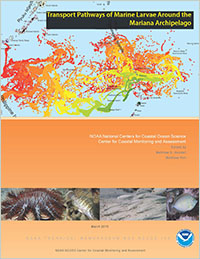-
Home
-
Data & Publications
-
Regional Portals
- About Regional Portals
- Florida
- Navassa Island
- Puerto Rico
- Flower Garden Banks
- U.S. Virgin Islands
- American Samoa
- Commonwealth of the Northern Mariana Islands
- Federated States of Micronesia
- Guam
- Main Hawaiian Islands
- Republic of the Marshall Islands
- Northwestern Hawaiian Islands
- Republic of Palau
- Pacific Remote Island Areas
-
CRCP Activities
- Glossary
Transport Pathways of Marine Larvae Around the Mariana Archipelago

Many coral reef organisms have a larval development phase in pelagic environments. These larvae may be returned to their natal islands or dispersed downstream in ocean currents. Understanding the strength and geographic patterns of this larval connectivity is an important part of managing marine ecosystems through ecosystem based-fisheries management plans, marine protected area (MPA) network design, recovery strategies for endangered species, and promoting reefs that are resilient to disturbance. Sufficient sources of larvae must be maintained to sustain future generations.
The overall goal of the assessment was to evaluate ocean currents as a mechanism of transport and to compare connectivity among larvae with different life-history characteristics using computer simulations. Cumulative connectivity over a recent 9 year span was investigated for the entire region. Island roles as larval sources and destinations, as well as self-seeding versus larval import, were evaluated for each of the Marianas. For Guam and Saipan, the two most populous islands, the seasonal and inter-annual variation in larval supply was examined.
Citation: Kendall, M.S. and M. Poti (eds.). March 2015. Transport Pathways of Marine Larvae Around the Mariana Archipelago. NOAA Technical Memorandum NOS NCCOS 193. Silver Spring, MD. 130 pp.
For more information contact:


